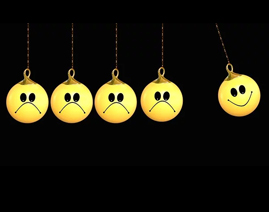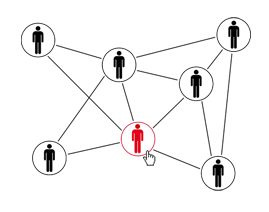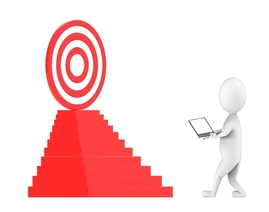4 Best Practices CEOs and Public Speakers Can Learn from Athletes
What struggles do CEOs and public speakers have in common with athletes?
For one, there’s the problem of nerves.
Part of my work as a public speaking coach is helping entrepreneurs overcome their fear of speaking in public, which according to one widely-quoted survey, was >worse than dying.
Athletes like> Lionel Messi and Hall of Fame basketball player> Bill Russell also experience the same anxieties before huge games. So much so, that they’ve been known to throw up because of the pressure!
The importance of the mental state in athletic performance is why teams like Chelsea FC >hire sports psychologists to help their players overcome mental blocks. Those that do often describe being able to go “in the zone” during clutch moments in a game or match.
This experience is what psychologist and author> Mihaly Csikszentmihalyi refers to as> Flow, or the state of complete immersion in an activity, often resulting in a loss of sense of space and time.
The late Formula One triple world champion> Ayrton Snna offers a vivid description of a Flow state he experienced during a qualifying circuit for the 1988 Monaco Grand Prix. He explained:
“I was at one stage just on pole, then by half a second, and then one second... and I kept going. Suddenly, I was nearly two seconds faster than anybody else, including my teammate with the same car. And I suddenly realized that I was no longer driving the car consciously.”
But what’s great about Flow is that it's not exclusive to athletes.
In an> article, Csikszentmihalyi writes that Flow can be triggered by having clear goals that require specific responses. It’s why Flow is easier in games like chess, tennis, and poker, where rules and goals are clearly defined for players to follow without having to think.
For public speakers and CEOs, a Flow state can mean being fully in control of a speech or presentation.
Everything just clicks: from rehearsed lines to gaining the audience’s trust, and even nailing the perfect timing with jokes.
The key to getting this peak performance? Practice, practice, and practice. Below are four sports psychology techniques used by athletes that you can apply to prepare for your next speech or presentation.
1. Practice Mindfulness Meditation
In 1988, Canadian researchers Terry Orlick and John Partington conducted >a study on 235 Canadian Olympic athletes who participated in the 1984 Olympic Games, seeking to find differences between those who medaled and those who didn’t.
They found that the only significant difference between the two groups was mental preparation.
This is where mindfulness meditation—>Mindfulness Meditation Training for Sport (MMTS) in the sporting world—comes in. It’s a mental conditioning technique used by pro athletes to overcome their fears through meditation focused on acceptance.
Mindfulness meditation can teach your mind to accept the fear of public speaking as just that—a fear. By acknowledging this sensation, it becomes easier to detach yourself from this fear and focus on your performance instead.
The science backs this up too. One >study found that just eight weeks of regular mindfulness meditation practice, whether through yoga or simply focusing on making slow breaths a few minutes each day, was enough to shrink the amygdala. This is the part of the brain that regulates the body fight-or-flight response. The findings of another >study of 24 patients also show that an eight-week meditation regimen was able to reduce the blood pressure of more than half of the patients by 10 systolic (the higher value) points and 5 diastolic (the lower value) points.
Being mindful is not inherently spiritual in nature. Instead, it’s the mental practice of detaching yourself from the need to impress. Interestingly, when you also come from a space to serve your audience, then your energies will be focus on helping them instead of thinking how you may impress them.
2. Develop a Pre-game Routine
On the surface, pre-game rituals and routines can seem absurd. But for athletes, the comfort and familiarity of a routine are the keys to getting in the proper mindset before a competition.
Players in all kinds of sports follow different routines and rituals because it gives them a sense of control. For example, Michael Jordan used to >wear the same set of University of North Carolina (his alma mater) shorts under his Chicago Bulls uniform because he believed it brought him good luck.
To the casual observer, it sounds like superstition.
But to Jordan, he believed in those shorts, and that’s what matters most.
And research shows that such rituals are powerful, capable of reducing anxiety before stressful tasks. In a >study analyzing stress before singing in public, a ritual found to be capable of reducing the singer’s heart rate by three beats per minute (BPM) — 4 BPM and 3 BPM lower than singing without a ritual and actively trying to calm down, respectively.
That being said, what kind of pre-speech routine should you have? Here are a few basic examples you can use:
- An hour before your speech, warm up your voice with> vocal exercises.
- Walk around the room, hall, or theatre to see what it’s like for people looking at you on stage. Make sure you know where to stand so you’re visible at all times
- Walk around the stage to get comfortable
- Test the microphone and sound system
- Run through your notes one last time
- Listen to calming music
- Meditate quietly in an open space or your seat
- Talk with and engage audiences who are early so you build some pre-engagement rapport with the people there
3. Be in Competition with Yourself
During the men's 200m butterfly final at the Rio Olympics, Chad le Clos made the mistake of >losing focus on his own lap, looking at Michael Phelps, who was in the lane next to his, in the middle of the race.
Phelps would go on to win his 20th gold medal that day.
The lesson here is that, while competition can be a good source of motivation, if it’s not channelled to improve yourself it’ll only cause you to lose focus of your own performance.
In his book, >Drive – The Surprising Truth about What Motivates Us, author Daniel Pink shares research warning that extrinsic motivation, or motivation from financial reward and competition, is unsustainable. Harvard Business Review also presents a strong case >against being motivated by competition, noting that for some people, it just doesn't work.
In contrast, intrinsic
In other words, if you’re going to compete, the better approach may be to compete against yourself. One way to do this is by setting goals for your public speaking performance, which can include:
- Learning to manage your emotions on the stage
- Learn from other speakers and how they deliver speeches
- Learn to give a memorized speech
- Practice talking in a clear and crisp voice
- Learn to research and talk about a topic you’re not familiar with
4. Practice Visualization Techniques
The quote, “Whatever the mind can conceive and believe, it can achieve,” by> Napoleon Hill is perhaps the best one-sentence explanation of how visualization works.
In sports psychology, visualization, also known as guided imagery and mental rehearsal, refers to the process of creating a mental image of what you want to feel or happen in reality. Research on the subject has also shown promising results, so much so that> Olympic athletes swear by it.
In one study, two groups of volunteers were >monitored over a three-month period to determine the effect of mental exercises on muscle strength. One group carried out physical exercises in the gym and saw a 35 percent increase in strength. The other group performed mental exercises and increase their strength by nearly half as much (13.5 percent).
Similar results were found in a> study on visualization on public speaking, with students who were asked to visualize feeling less anxious about making a speech than those who were not asked to do so.
Examples of basic visualization exercises for public speaking include:
- Visualize positive results every day leading to your speech. Find a quiet place where you can calm your mind and meditate on a positive outcome.
- Visit the location of your speech or presentation. This will help you know what to expect and visualize your performance more vividly.
- Visualize your body language. Imagine yourself standing confident on stage, ready to answer questions succinctly.
- Visualize applause and positive reception. This will help build your confidence and enthusiasm to deliver a great presentation.
Wash, Rinse, Repeat
Consistency, practice, and vision are things the world’s top athletes use to set themselves up for success on game day. Public speakers and CEOs can also use these sports psychology techniques leading up to a big public speaking event to mentally condition themselves for peak performance. If you have a strong aversion to public speaking, this will be easier said than done. But as >Muhammad Ali said about training,
“I hated every minute of training, but I said, ‘Don’t quit. Suffer now and live the rest of your life as a champion.’”
You May Also Like

The CMO of People
Many organizations are not getting the best out of their HR function. Ask a CEO, “What is your...

The Challenges of Hiring Future Ready Leaders and Russian Doll Theory of Hiring
One of the biggest challenges most companies face today is hiring transformational leadership talent...

Why Do Most Innovation Programmes Fail?
What do companies do when a new boss says “Innovation has to be part of our DNA”? Here ...

The Greatest Resource any Organization has is the Creativeness of People
For too many years people have been treated as expense items instead of highly valuable resources. T...

How To Quit A Job You Love
It is not easy to quit a job you love. Even with a new dream job in-hand, cutting the cord that conn...

Take on Mistakes
Yes, we do say mistakes teach you a lot and you shouldn’t be afraid of making mistakes. But we...

Five Stages Of Organization Evolution And Key Characteristics And Concerns At Each Stage
Organizations almost always progress through five more-or-less well-defined evolutionary growth stag...

Managing in Multi-Cultural Environment
As several companies expands the business overseas, it is crucial to understand how to run the busin...

Crossing Corporate Cultures Creativity In Organizations Across Industries
Every market has its own unique business practices. People working in different business sectors dev...

Four pillars of Yoga for holistic health
Every human is unique; therefore it is necessary for each of us to find out for ourselves how we can...

Brave to Lead Like a Girl
All of us are dealt a unique deck of cards. Our aim is to identify our strengths and play those card...

How do you Extend Influence to Others and Change Lives?
You Change Lives When You Empower Others! (Extending Influence #1) When you empower others you chan...

How Important is Vision in a Successful Life?!
Understanding Vision (How Important is Vision #1) How do you communicate and give vision to ...

How do you Extend Influence to Others and Change Lives?
You Change Lives When You Empower Others! (Extending Influence #1) When you empower others y...

High Potentials vs High Performers
A Leaders Guide to Identify the Differences Mistaking a high-performing employee for...

Is 7% good enough?
A topic discussed at the recent World Economic Forum was the reluctance of male executives to mentor...

Learning & Development as Part of a (Digital) Transformation Strategy
The global workforce is constantly evolving to support a knowledge based, digital economy. Due to th...

The Future of Work – Digital Nomads and the Gig Economy
It is estimated that within a short couple of years, a large portion of the workforce (estimated to ...

Political Correctness towards Civility To be, or not to be, politically correct...
We can incidentally praise or criticize others depending on how we say it, the word choice or expres...

Let's not confuse loyalty with longevity
Let's not confuse loyalty with longevity It is interesting that the issue of loyalty in the wor...

The Attitude of Gratitude - Replying does not mean Answering
The Attitude of Gratitude - Replying does not mean Answering In the ever increasingly connected di...

(Work-Life) Balance or Harmony (! / ?)
(Work-Life) Balance or Harmony (! / ?) Welcome to the world of Work-Life Harmony, beyond Work-Life...

Making Board Meetings More Agile
Making Board Meetings More Agile Given my belief that the world we live in today has changed irreve...

It's Good To Fail
It's Good To Fail I want to share with you something different from a normal convocation speech...

Four Lifehacks To Be More Productive Now
Four Lifehacks To Be More Productive Now Here are four daily life-hacks to help you to be more pr...

A leader sets an example, a leader doesn’t just order things, he does it so that others can do it
A leader sets an example, a leader doesn’t just order things, he does it so that others can do...

How would you end Executive Loneliness?
How would you end Executive Loneliness? What is the hardest part about being a leader? Altho...

Leadership Soft Skills Required for Business and Personal Success
Leadership Soft Skills Required for Business and Personal Success We often get asked, “What s...

New-G Leaders: Remember the Cow
New-G Leaders: Remember the Cow "Cow Don't Drink Water, Cannot Push Cow Head Down"&nbs...

Google your self
What are your key leadership attributes? The beliefs and behaviours that make you unique and success...

Culture is not enough … Get the right culture
A few years ago in Europe I asked a group of business leaders if they had the right culture. S...

How Leaders Can Create a Culture of Agile Collaboration to Win in a VUCA World
China growth-deceleration, the normalisation of monetary policies on the USA, tepid economies in Eur...

Is LinkedIn Improving Itself Out of Business?
I still remember the day I joined LinkedIn. A friend of mine called in frustration and asked w...

Life is the Name. Transformation is the Game.
Over the past half a century, I come to realize life is about having gratitude and resilience. We ne...

How to handle negativity and negative colleagues at work
In arithmetic's, negative into negative equals positive. But that’s just in arithmetic'...

ADAPT or PERISH: It is time for HR professionals to decide and create a new function or move out of the way!
Artificial intelligence in recruitment and performance management giving employees their key deliver...

Leadership Confidence in Times of Uncertainty
How do you successfully lead an organization in uncertain challenging times? Unparalleled st...

Insights for Making Working at Home Work!
How can business and HR leaders manage challenges and find opportunities in the new realities of wor...

The Real You Is Not Really You…
The Real You Is Not Really You… We tend to see and act with our surrounding based o...

3 Powerful Lessons To Make A Successful Career Out Of Your Passion
It Feels Like a Dream As I went on stage today to receive the Asia's Most Talented Coaching Lea...

How to Recover Your Direction - a case study during COVID19
What really happened 5 days ago I set myself a new challenge. Coronavirus had fundamentally changed...

Career Tips, Please
Last week, I was tagged by the fab Tim McDonald in a LinkedIn post asking to share some pointers for...

Impact of AI on the workforce Pre and Post the Pandemic
With the sudden advent of COVID-19 - a global crisis of unprecedented scale, organisations now are c...

Career Kickstart
The first job you land could be the most important decision you make in your career. I have seen th...

Peter Principle - Are you a victim or Perpetrator?
The Peter Principle – Who do YOU Blame? In my junior years of business, many times clients an...

Who do you want to be in COVID-19?
Whilst reviewing friend’s pages on Facebook, previous colleagues, mentors and my business netw...

TRUST – The core enabler that influences and inspires your team
These are certainly extraordinary times for leaders. What do employees need from leaders? In...

On Mentoring
I attended a conference some years back. At one point when the speaker asked, “How many of us...

Men of Faith
Mankind is meant to create, both with their body and mind because that creates balance within. It ke...

What Being on TED Taught Me About Comfort Zones
“In order to grow, you’ll need to step outside your comfort zone.” We’ve al...

3 Tips for Setting and Achieving Goals
Last week I wrote about when setting goals for 2021 we should Go Big or Go Home because it...

Never ask employees what would make them happy at work. Do this instead...
Most managers have realized by now that happy workplaces are more productive, more creative, attract...

How to Choose the Right HRMS Product/Platform
The size of the business has become irreverent when it comes to the technology embracing, to remain ...

So, #IWD is done - where to next?
This week saw a record number of events to mark International Women's Day by organisations - bot...

The trauma of being “made redundant”
At work, there’s nothing quite as horrifying as the experience of being “made redundant&...

My Hopes and Dreams for Malaysia in 2021
Let’s face it – 2020 was not what we envisioned it to be. Since the start of last year, ...

What could post COVID mean for organizations?
This article was co-authored by Dave Ulrich. During this time of limited human interaction, we...

The foolproof way to get a new team to start collaborating, quicker – even in hybrid work environments!
The >#wfh environment does not give us enough organic opportunities to break the ice with ...

Why Do I Keep Hiring the Wrong People?
According to Hudson Singapore, 37% of employers are expecting to increase headcount in the first hal...

Being a Business Woman was Never My Plan
I never wanted my own business. It was never in my plans. Sure, I have an MBA. And, yes I have a fam...

The great resignation or attraction! Is this about work-life balance....or work life purpose?
In recent weeks, there have been many studies by McKinsey, Microsoft and others published that indic...

Tune in to your self to stay tuned to work
I began writing an article on LinkedIn in early 2018 with the same title and saved it as a draft. Th...

Self-Leadership - The Critical Success Factor
What is the critical factor for any organization, large or small, to achieve success? Is it a clear...

Appreciation at Workplace
One of my early memories of my first job after graduating is that working life was terrible. Why did...

The 6 'HABITS' of highly successful “Assistants”
No matter what your title, it is most definitely how you think, what you say and your behaviour that...

AI Thinking I We are Heading Towards Self-Awareness Machine (AGI)
AI Thinking I We are Heading Towards Self-Awareness Machine (AGI) Neuralink It is a neurotechnolog...

Are Capitalism and Democracy Compatible?
Are Capitalism and Democracy Compatible? America prides itself on being able to run two great syste...

The Neurodiverse An Untapped Pool of Exceptional Talent
Our understanding of the brain and how it works so magnificently, has increased exponentially over t...

Everyone's a Great Writer Now! So Why Does Reading Feel So Empty?
Everyone's a Great Writer Now! So Why Does Reading Feel So Empty? AI can make anyone sound like...








Benjamin Loh
Executive Public Speaking Coach, TEDx Speaker, Author and Professional Speaker on Millennial Matters.
As the youngest Associate Certified Coach in Singapore and possibly, Asia-Pacific, he has coached over 100 corporate executives and entrepreneurs individually with over 750 hours of direct coaching and trained over 3,500 clients in high impact mass trainings in public speaking, presentation skills and leading the multi-generational workforce and Millennials. His work in entrepreneurship and public speaking has been featured on over 60 occasions on both local and regional media platforms like Channel News Asia (CNA), Vietnam QKTV, BFM Malaysia, Radio Television Hong Kong (RTHK), Straits Times (ST), Business Times (BT) and News938 Live.